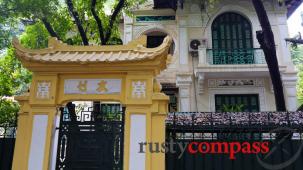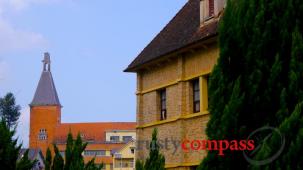The first extraordinary thing about the Viet Cong tunnel complex at Cu Chi is its proximity to Saigon. If ever there was a sign of the uphill battle facing US and South Vietnamese forces, it was this communist stronghold that persisted throughout the war just seventy kilometres from the seat of South Vietnamese and American power.
The foliage around the tunnels seems to be strangely devoid of undergrowth. The area was extensively napalmed and defoliated but my guide was insistent that the strange cover was not defoliant related.
The tunnels were close to Saigon - but they were even closer to the US air base that ran above them.
Visitors are shown a short and surreal propaganda film from the 1960s depicting the glorious lives of the tunnel fighters. The video pulls no punches and has no doubt created great discomfort amongst some foreign visitors. It remains a special artefact of war time propaganda - traces of which are increasingly difficult to find as Vietnam tailors its message for the globalised world.
A guide explains the three levels of the complex.
A tour guide is compulsory for foreign tourists and this guide did a great job. When the tunnels first opened to foreign visitors, many of the guides were former tunnel guerillas.
This man lost an arm in combat at Cu Chi and was a guide at the tunnels in the early nineties.
Left overs from war
Some historians argue that Cu Chi is the most bombed patch of land in the history of warfare. It was part of an area known to Americans as the Iron Triangle for its dogged resistance to relentless attack.
More deadly leftovers
B52 crater
The area around the tunnels is potted with enormous ditches that remain from the B52 aerial raids. Even forty years on, the holes give a sense of the horrendous power of these weapons.
Our guide demonstrates how well camouflaged the tunnel entrances were.
The South Vietnamese and US soldiers became aware of the tunnels and tried to bomb them out of existence. A group of foreign soldiers known as tunnel rats were charged with entering the booby trap infested tunnels to destroy them and hunt down enemy soldiers.
Going...
Gone...
Willing travellers are invited to enter selected tunnels that have been enlarged for Western frames. The short crawl gives a very limited sense of what life would have been like for the Cu Chi fighters. Most emerge from a few minutes breathing the thick humid air and warding off bats, in disbelief that people could have spent long periods living in these conditions.
Viet Cong underground meeting room.
The banner in the background carries the words of Ho Chi Minh - “nothing is more precious than independence and freedom”. Next to the hammer and sickle is the flag of the VC properly known as the National Liberation Front (NLF).
Booby trap in the corner of the meeting room.
This gallery showcases the array of ghastly traps used to disable and maim enemy soldiers.
The guides and staff dress in guerilla uniforms.
This Huey helicopter is another piece of US military equipment at the Ben Duoc Cu Chi tunnels.
In the nineties, this memorial was built to honour the thousands who lost their lives fighting in and around the Cu Chi district.
Viet Cong graveyard not far from the tunnels at Ben Duoc.































